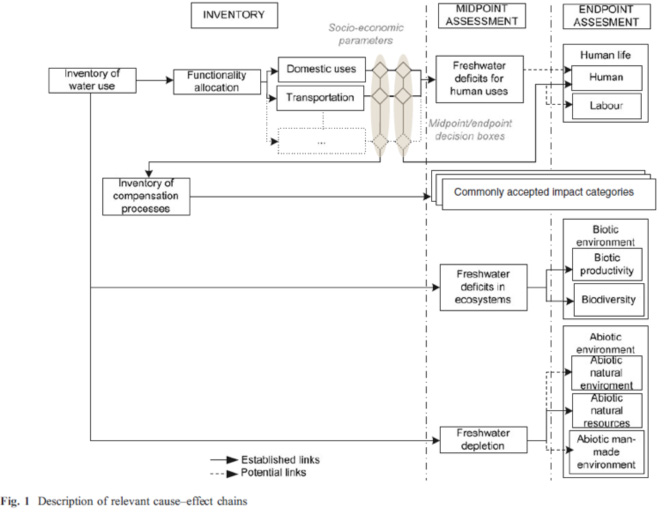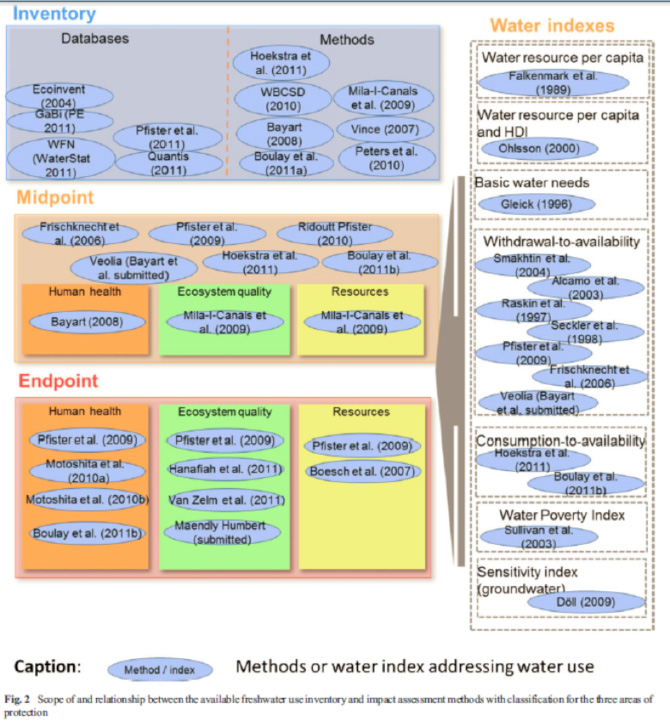April 2008
Completed
23 months
Jean-Baptiste Bayard
Cécile BULLE (CIRAIG); Louise DESCHENES (CIRAIG); Manuele MARGNI (CIRAIG); Stephan PFISTER (ETH Zurich); François VINCE (Veolia); Annette KOEHLER (ETH Zurich).
Emmanuelle AOUSTIN (Veolia); Pablo ARENA (Universidad Tecnológica Nacional-Facultad Regional Mendoza;) Ronnie JURASKE (ETH Zurich); Christian BAUER Markus BERGER (TU Berlin); Rolf FRISCHKNECHT (ESU Services); Mark HUIJBREGTS (Radboud University); Sébastien HUMBERT (Quantis); An de SCHRYVER (Pré Consultant); Rosalie VAN ZELM (Radboud University); Bo WEIDEMA (ecoinvent); Anne-Marie BOULAY (CIRAIG).
A framework for assessing off-stream freshwater use in LCA
Bayart, J. B.; Bulle, C.; Deschenes, L.; Margni, M.; Pfister, S.; Vince, F.; Koehler, A. «A framework for assessing off-stream freshwater use in LCA» International Journal of Life Cycle Assessment 2010, 15, 439-453
This paper aims to develop a framework to support further quantitative modeling of the cause–effect chain relationships of water use. The framework includes recommendations for life cycle inventory (LCI) modeling and provides a description of possible impact pathways for life cycle impact assessment (LCIA), including indicators on midpoint and endpoint levels that reflect different areas of protection (AoP).

June 2009
Completed
36 months
Anna Kounina (Quantis)
Manuele Margni (CIRAIG); Jean-Baptiste Bayart (Veolia); Anne-Marie Boulay (CIRAIG); Markus Berger (Technische Universität Berlin); Cécile Bulle (CIRAIG); Rolf Frischknecht (ESU Service Ltd); Annette Koehler (PE international); Llorenc Mila-i-Canals (Unilever); Masaharu Motoshita (National Institute of Advanced Industrial Science and Technology); Montserrat Núñez (LBE-INRA); Gregory Peters (Chalmers University of Technology); Stephan Pfister (ETH); Brad Ridoutt (CSIRO); Rosalie van Zelm (Radboud University); Francesca Verones (ETH); Sebastien Humbert (Quantis).
Adisa Azapagic (University of Manchester); Damien Arbault (CRP Henri Tudor); Emmanuelle Aoustin (Quantis) Jane Bare (EPA); Enrico Benetto (CRP Henri Tudor); Michael Boesch (Aveny); Marlia Hanafiah (Radboud University); Arjen Hoekstra (WFN); Tereza Levova (Ecoinvent); Sven Lundie (PE); Sonia Valdivia (UNEP); Samuel Vionnet (Quantis).
Review of methods addressing freshwater use in life cycle inventory and impact assessment.
Kounina, A., M. Margni, et al. (2013). “Review of methods addressing freshwater use in life cycle inventory and impact assessment.” The International Journal of Life Cycle Assessment 18(3): 707-721.
This work reviewed several methods describing the inventory and impact assessment of freshwater use potentially applicable in LCA. This review is used as a base to identify the key elements to build a scientific consensus for an operational characterization method for LCA.

May 2012
Under Review
12-24 months
Anne-Marie Boulay (CIRAIG)
Cécile BULLE (CIRAIG); Helen FRANCESCHINI (Unilever); Manuele MARGNI (CIRAIG); Masaharu MOTOSHITA (Japan); Ivan MUNOZ (Unilever); Stephan PFISTER (ETH Zurich).
Jean-Baptiste Bayart (Quantis)
Boulay A-M, Motoshita M, Pfister S, Bulle C, Muñoz I, Franceschini H, et al. 2014. Analysis of water use impact assessment methods (part a): Evaluation of modeling choices based on a quantitative comparison of scarcity and human health indicators. The International Journal of Life Cycle Assessment:1-22.
Boulay, A.-M., Bayart, J.-B., Bulle, C., Franceschini, H., Motoshita, M., Muñoz, I., Pfister, S., et al. (2015). Water impact assessment methods analysis (Part B): Applicability for water footprinting and decision making with a laundry case study. International Journal of Life Cycle Assessment (20): 865–879.
This paper is divided into two parts and aims to broaden the understanding of existing water use impact assessment methods and their applicability within a water footprint study. Part A focuses on identifying relevant modeling choices to analyze the main differences between water impact assessment methods and assess their overall variability and model uncertainty. Part B illustrates the applicability of water footprint methods through a case study and discusses the methods’ consistency, reliability and limitations for decision making. Sensitivity analyses on the case study were selected based on relevant modeling choices determined in part A.
The WULCA working group’s overall goal focuses on providing practitioners, from both industry and academia, with a consensual and consistent framework to assess, compare and disclose the environmental performance of products and operations regarding freshwater use. In addition to create a discussion platform that boosted the scientific research around water use in LCA, WULCA significantly influenced the creation of the draft standard ISO DIS 14046 on water footprinting: five members of WULCA, including the convener, were directly involved as national representatives within the ISO process. The main scientific deliverables so far have been a framework for water use impact assessment in LCA (Bayart et al., 2010), a review of existing methods for water use in LCA (Kounina et al., 2013),and under review are two papers from a quantitative method comparison and application (Boulay, Bayart, et al., 2013; Boulay, Motoshita, et al., 2013) and a numerous of disseminating activities, including scientific seminars and trainings. These outcomes serve as building blocks for the development of a consensual method.
In May 2013, WULCA received the mandate from the UNEP SETAC Life Cycle Initiative (Project on Global Guidance on Environmental life cycle impact assessment indicators ) to lead the harmonization and consensus building for the water use impact category.
The objective of this specific project conducted within WULCA working group was therefore to coordinate the consensuses building process and lead the scientific work into achieving a harmonized method for assessing water use in LCA, involving key method developers and stakeholders through an international collaborative effort.
Please consult all the details of this deliverable in the AWARE section.
Núnez M, Rosenbaum RK, Karimpour S, et al (2018). A Multimedia Hydrological Fate Modeling Framework to Assess Water Consumption Impacts in Life Cycle Assessment. Environ Sci Technol 52
Many new methods have recently been developed to address environmental consequences of water consumption in life cycle assessment (LCA). However, such methods can only partially be compared and combined, because their modeling structure and metrics are inconsistent. Moreover, they focus on specific water sources (e.g., river) and miss description of transport flows between water compartments (e.g., from river to atmosphere via evaporation) and regions (e.g., atmospheric advection). Consequently, they provide a partial regard of the local and global hydrological cycle and derived impacts on the environment. This paper proposes consensus-based guidelines for a harmonized development of the next generation of water consumption LCA indicators, with a focus on consequences of water consumption on ecosystem quality. To include the consideration of the multimedia water fate between compartments of the water cycle, we provide spatial regionalization and temporal specification guidance. The principles and recommendations of the paper are applied to an illustrative case study. The guidelines set the basis of a more accurate, novel way of modeling water consumption impacts in LCA. The environmental relevance of this LCA impact category will improve, yet much research is needed to make the guidelines operational.
Pradinaud C, Northey S, Amor B, et al (2019). Defining freshwater as a natural resource: a framework linking water use to the area of protection natural resources. Int J LCA
Purpose
While many examples have shown unsustainable use of freshwater resources, existing LCIA methods for water use do not comprehensively address impacts to natural resources for future generations. This framework aims to (1) define freshwater resource as an item to protect within the Area of Protection (AoP) natural resources, (2) identify relevant impact pathways affecting freshwater resources, and (3) outline methodological choices for impact characterization model development.
Methods
Considering the current scope of the AoP natural resources, the complex nature of freshwater resources and its important dimensions to safeguard safe future supply, a definition of freshwater resource is proposed, including water quality aspects. In order to clearly define what is to be protected, the freshwater resource is put in perspective through the lens of the three main safeguard subjects defined by Dewulf et al. (2015). In addition, an extensive literature review identifies a wide range of possible impact pathways to freshwater resources, establishing the link between different inventory elementary flows (water consumption, emissions, and land use) and their potential to cause long-term freshwater depletion or degradation.
Results and discussion
Freshwater as a resource has a particular status in LCA resource assessment. First, it exists in the form of three types of resources: flow, fund, or stock. Then, in addition to being a resource for human economic activities (e.g., hydropower), it is above all a non-substitutable support for life that can be affected by both consumption (source function) and pollution (sink function). Therefore, both types of elementary flows (water consumption and emissions) should be linked to a damage indicator for freshwater as a resource. Land use is also identified as a potential stressor to freshwater resources by altering runoff, infiltration, and erosion processes as well as evapotranspiration. It is suggested to use the concept of recovery period to operationalize this framework: when the recovery period lasts longer than a given period of time, impacts are considered to be irreversible and fall into the concern of freshwater resources protection (i.e., affecting future generations), while short-term impacts effect the AoP ecosystem quality and human health directly. It is shown that it is relevant to include this concept in the impact assessment stage in order to discriminate the long-term from the short-term impacts, as some dynamic fate models already do.
Conclusions
This framework provides a solid basis for the consistent development of future LCIA methods for freshwater resources, thereby capturing the potential long-term impacts that could warn decision makers about potential safe water supply issues in the future.
A Pellston workshop is a consensus-building process as per the SETAC process. Details on Pellston workshop process can be found here. In the 2016 Pellston workshop of the UNEP SETAC Life Cycle Initiative, consensus was built on water use methods related to water scarcity (AWARE method) and human health impacts. The complete report can be found here.